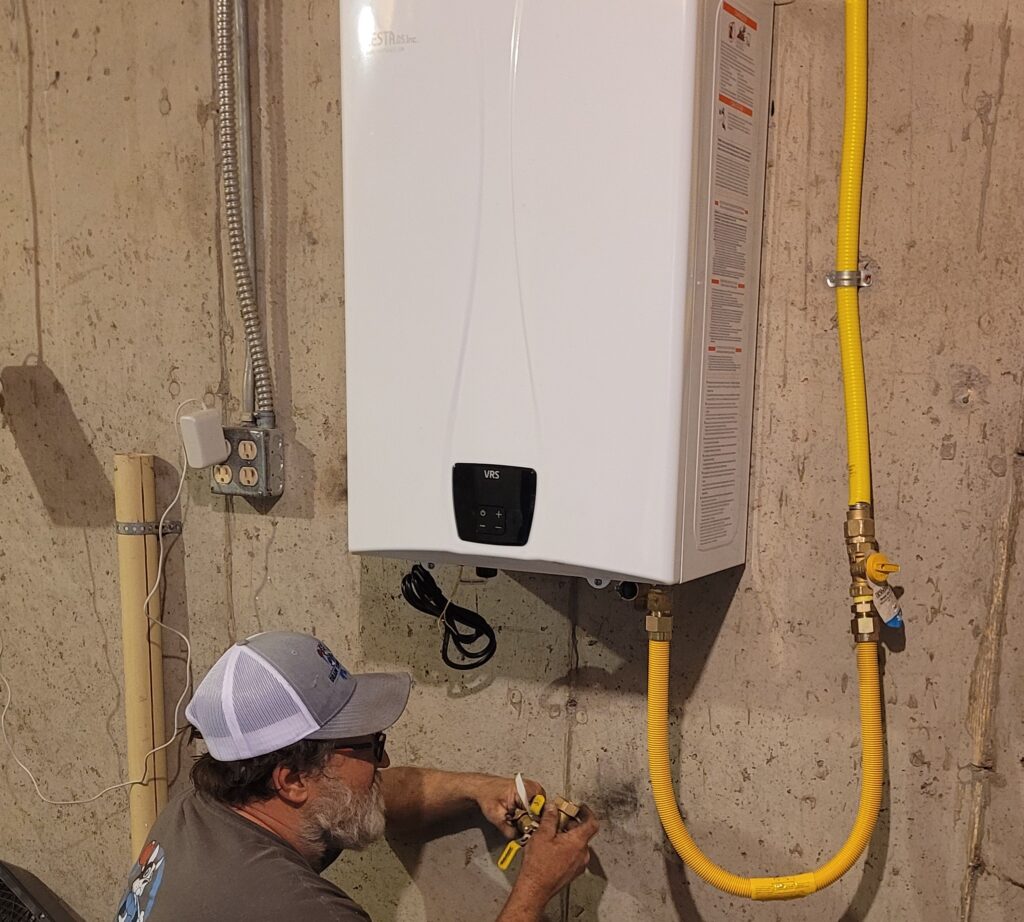Upgrading to a tankless water heater can revolutionize your home’s hot water supply, offering energy savings and eliminating the frustrations associated with running out of hot water. This step-by-step guide will walk you through what to expect during a tankless water heater installation, including home preparation, potential challenges, and why professional help is essential. Whether you’re upgrading from traditional tank water heaters or installing a tankless model for the first time, here’s everything you need to know.
1. Choosing the Right Tankless Water Heater
Tankless water heaters, also known as demand water heaters, are available in both gas and electric models. To meet your home’s hot water demand, you’ll need to choose a unit that can supply enough hot water for multiple fixtures without interruptions. Unlike storage tank water heaters, which hold a tank of water, tankless systems heat water only when needed, reducing standby heat loss and providing energy-efficient performance.
Considerations:
- Flow rate: Calculate how many gallons per minute (GPM) your household requires, particularly during peak usage times. This will ensure the hot water tap never runs dry.
- Incoming water temperature: Colder climates may require a more powerful unit to raise the water to the desired temperature.
- Energy usage: Tankless water heaters are designed to cut energy costs by eliminating the constant heating of a storage tank, unlike conventional storage tank water heaters.
2. Installation Location
Choosing the right location for your tankless water heater is crucial for maximizing space and efficiency. The compact size of tankless units allows for installation in smaller areas such as utility rooms, closets, or even under stairs. However, it’s important to avoid placing the unit in overly humid areas or near water pipes that might leak.
3. Gas Connection and Ventilation
For gas models, you’ll need to ensure your home has a sufficient gas connection to power the water heater. Tankless units require a larger gas supply than traditional tank water heaters because they heat water on demand. A licensed plumber will confirm whether your home’s gas line is large enough to support the new unit.
Ventilation is also crucial for gas water heaters. Proper venting is required to safely expel exhaust gasses. Some units may require stainless steel venting materials, while others, like condensing models, can be vented with PVC. Your plumber will ensure that your system meets local codes and operates safely.
4. Electrical Requirements for Electric Models
If you opt for an electric tankless water heater, you’ll need to check that your home has the proper electrical setup. Electric units require a dedicated power source to operate effectively. Depending on the model, you may need to upgrade your home’s electrical panel to meet the energy requirements of your new electric water heater.
5. Water Heater Installation Costs
The water heater installation costs for a tankless unit can be higher than those for conventional water heaters, ranging from $1,200 to $3,500, depending on the complexity of the installation. However, the long-term energy savings and the elimination of energy waste typically offset the upfront cost. Additionally, tankless water heaters can last up to 20 years, outliving traditional tank water heaters by nearly a decade.
6. Maintenance Tips for Longevity
Maintaining your tankless water heater is key to ensuring it operates efficiently over time. Unlike storage tank water heaters, tankless units are prone to mineral buildup in hard water areas. Regular descaling, especially for electric heaters, is recommended to prevent reduced water flow and efficiency. Follow these maintenance tips to keep your system in top condition:
- Flush the unit annually to remove mineral deposits.
- Check for any signs of leaks or blockages in the gas or water lines.
- Inspect the venting system for any clogs or debris.
By adhering to these maintenance practices, you can extend the lifespan of your unit and avoid inconvenient cold showers.
7. Benefits of Going Tankless
There are many reasons homeowners are making the switch from traditional tank water heaters to tankless systems:
- Energy efficiency: By heating water on demand, tankless models eliminate the constant heating of a tank of water, saving you money on energy usage.
- Endless hot water: A properly sized tankless unit can meet your entire household’s hot water demand, even during high usage times.
- Compact size: Free up space in your home with the compact design of a tankless water heater.
- Longer lifespan: Tankless units last longer than traditional models, reducing the frequency and cost of replacements.
8. Professional Installation is Key
While some homeowners may be tempted to attempt DIY installation, hiring a professional tankless water heater expert is essential. Proper installation ensures your unit is safe, efficient, and compliant with local building codes. A licensed plumber will ensure the gas connection, venting, and power source are all properly set up to avoid potential issues down the road.
Call Drain Terrier for Expert Installation!
Ready to experience the benefits of a tankless water heater? Trust the experts at Drain Terrier for a smooth and professional installation. We handle everything from selecting the right unit to ensuring your home’s energy efficiency is maximized. Say goodbye to cold showers and hello to endless hot water!
Call us today at (720) 999-6120 or schedule an appointment online. Drain Terrier is here to make your water heater installation hassle-free and ensure your home enjoys all the benefits of an efficient tankless water heater for years to come.

